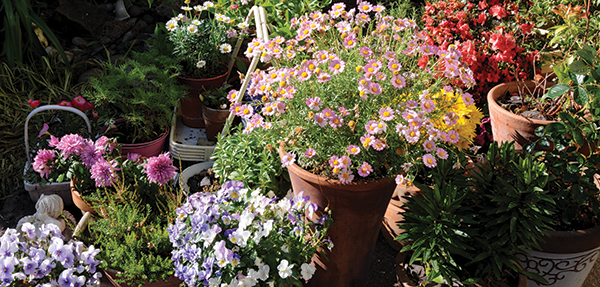Three low-maintenance perennial container ideas that will work in very different urban environments
by Laura Everard
When you’re choosing your own plants for a perennial planter, look for those with similar requirements for sun exposure, watering and soil type. Each of these ideas is designed to create a fantastic arrangement that will wow year-round.
Hot, Sunny and Dry
These pots require almost nothing but sunlight. Infrequent watering and a little fertilizer is all they need.
- 1x Stonecrop (Sedum telephium “Autumn Joy”) – a succulent that blooms with large pink flower clusters in the fall. Cut it back once it declines in the winter.
- 1x Angelina Sedum (Sedum rupestre “Angelina”) – a chartreuse succulent that is a great cascading plant. It adds fine, evergreen texture to planters year-round.
- 1x Dragon’s Blood Stonecrop (Sedum spurium “Schorbuser Blut”) – A spiller that has beautiful green and burgundy leaves. The newer leaves are evergreen and turn a deep red before overwintering. This plant will add color and depth.
- 2x Variegated Yucca (Yucca filamentosa “Color Guard”) – A show stopping evergreen that sports vibrant green and yellow spikes.
- 2x Eastern Prickly Pear Cactus (Opuntia humifusa) – People are always surprised when they find out that this plant is actually found in the wild around this region. Its random, spreading growth yields paddle-shaped evergreen stems. Watch out for the spines! If it flowers, you may be lucky enough to get some tasty fruit, which are high in vitamin C!
Sun/Part-Sun
Some late-fall pruning is required. Water these plants about once or twice a week. Fertilize a few times each season.
- 1x Umbrella Pine (Sciadopitys verticillata) – A statement pine tree with unusual needle clusters that will last as a centerpiece for years.
- 2x Heavenly Bamboo (Nandina domestica “Firepower”) – A dwarf evergreen shrub that has green foliage with pinkish new growth until the fall when it blazes into glory with vibrant red leaves.
- 1x Bugleweed (Ajuga reptans “Chocolate Chip”) – An evergreen groundcover that has leaves ranging from bronze to green. Its purple flowers are a nice bonus in mid to late spring.
- 2x Mexican Feather Grass (Nassella tenuissima “Pony Tails”) – A flowing grass that is often treated as an annual, but can be perennial if the winter is mild. The blades are green but turn mostly brown as the year progresses. They should be cut back in the winter.
- 2x Gaura (Gaura lindheimeri “Whirling Butterflies”) – This plant has incredible white and light pink flowers from May through October. The flower stalks should be cut back in the late fall.
Shade/Part-Shade
Water about once a week, but make sure the pot does not dry out! Fertilize a few times each season.
- 1x Bugbane (Actaea matsumurae “White Pearl”) – Dark green, serrated foliage with long white blooms on tall stalks in the late summer/early fall. Cut back in the winter.
- 1x Coral Bells (Heuchera americana “Green Spice”) – This perennial comes in almost any color! The evergreen leaves are the most prized part of the plant, although flower stalks appear in the late spring. Prune out any dead leaves in the early spring.
- 1x Creeping Jenny (Lysimachia nummularia “Aurea”) – A dainty chartreuse trailer that can be trimmed into any shape. Cut back in winter.
- 1x Japanese Painted Fern (Athyrium niponicum var pictum) – A fern with unusual purple stalks with silvery fronds that turn green as they mature. Prune out any dead fronds when needed.
- 1x Toad Lily (Tricyrtis hirta) – A nondescript filler that yields gorgeous purple, spotted flowers in the late summer and fall. Prune back in the winter.
How to Maintain Your Pot
- Plan ahead, know what your plants need and augment your perennials with your favorite annual plants to get beautiful results for years to come.
- From a visual perspective, choosing plants for a planter is all about texture, color and varying heights. Flowers are frequently in the spotlight due to their instant impact, but often only make an appearance for one season. Many flowering perennials require diligent deadheading throughout their season to perform to their true potential, so if you require a low maintenance garden, flowers may not be the way to go. Also, if your planter is in the shade, many plants won’t even bloom, so foliage is often the wiser choice.
- Regardless of location, all planters should have holes in the bottom and soil that offers proper drainage or else your plants will rot.
- Add seasonal annuals or cuttings to fill in any bare spots in the late fall through the very early spring.
- Always water thoroughly, regardless of the arrangement, but control the frequency. Most plants do not need much water to survive, and watering too frequently will kill them!
- Adding compost and fertilizers that are appropriate for the plants is also suggested for a long lasting, happy arrangement.
- Adding a layer of mulch can help with water retention, and can provide some frost protection.
- Always research perennials before you purchase them. They may look cute and little now, but some may grow a lot in size, and their form can change drastically. Although pruning can control some plants, it is best to select a plant based on its final form so it can flourish unhindered.
- Experiment! There are no rules when it comes to gardening. Most planters offer a horizontal plane, but sometimes a vertical planting approach might be more appropriate to optimize available space and light.
Laura Everard is a horticulturalist with Graceful Gardens.








